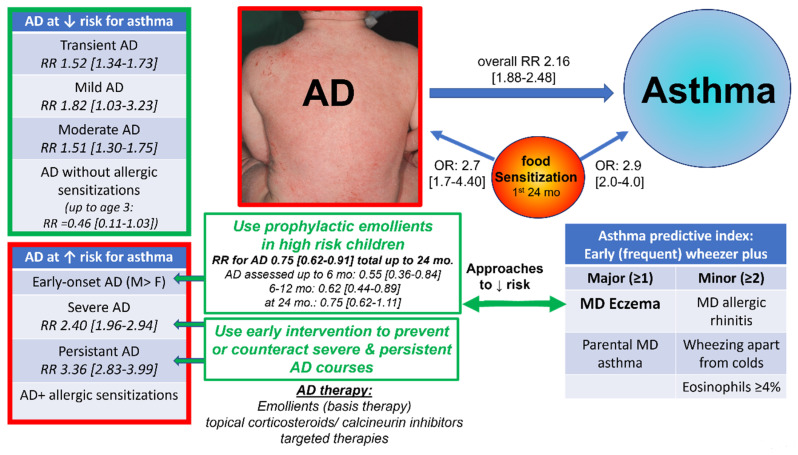Figure 1.
Atopic dermatitis with risk factors for the development of asthma, and implications for prophylactic and therapeutic intervention. Prophylactic emollients may contribute to the prevention or, at least, delay the early onset of AD within the first year of life. AD with early-onset, severe, and persistent disease course are at a higher risk for asthma. Early intervention and adequate treatment of AD might prevent the progress from mild and transient AD to severe and persistent forms, and in already existing severe AD, might contribute to downregulation of the severity and persistence of AD. This, in turn, might reduce the risk of the development of asthma = 95% Confidence interval, MD= physician diagnosis, mo=months, OR = odds ratio, RR = risk ratio. Effect sizes of risk factors [14,74], and the Asthma Predictive Index (API) estimating the probability of the development of asthma in a child with a history of wheezing [75,76,77], have been adapted from the literature. The Table with the API has been modified and adapted from: JOSÉ A. CASTRO-RODRÍGUEZ , CATHARINE J. HOLBERG, ANNE L. WRIGHT , and FERNANDO D. MARTINEZ/2000/ A Clinical Index to Define Risk of Asthma in Young Children with Recurrent Wheezing/Am J Respir Crit Care Med/Vol 162. pp 1403–1406, 2000. Adapted with permission of the American Thoracic Soci-ety. Copyright © 2022 American Thoracic Society. All rights reserved. The American Journal of Respiratory and Critical Care Medicine is an official journal of the American Thoracic Society. Readers are encouraged to read the entire article for the correct context at https://www.atsjournals.org/doi/full/10.1164/ajrccm.162.4.9912111. The authors, editors, and The American Thoracic Society are not responsible for errors or omissions in adaptations.

